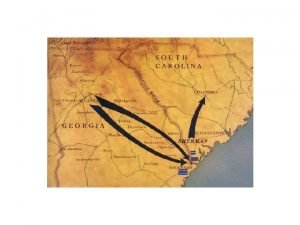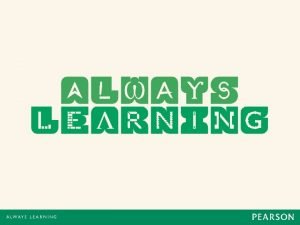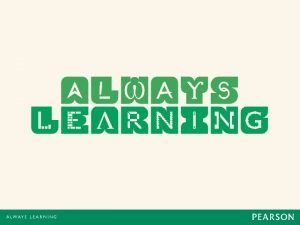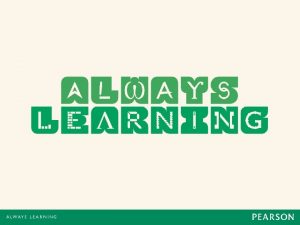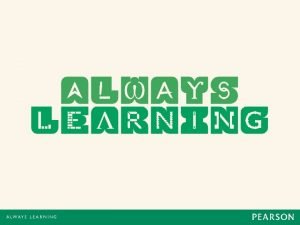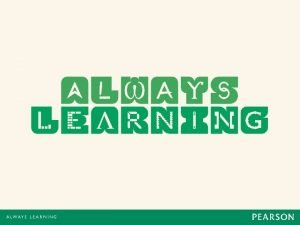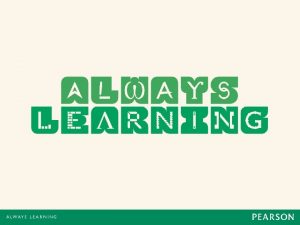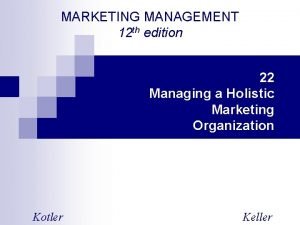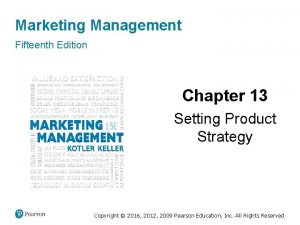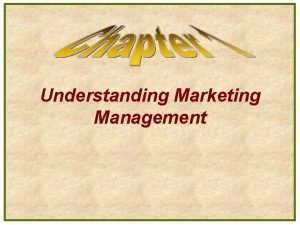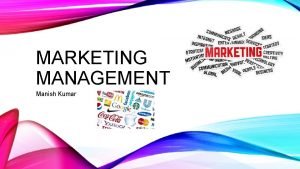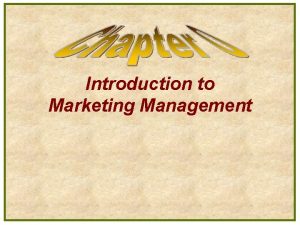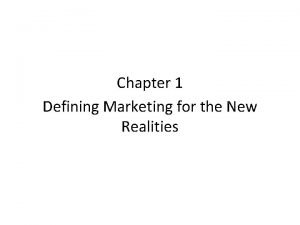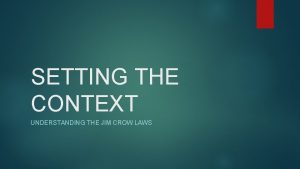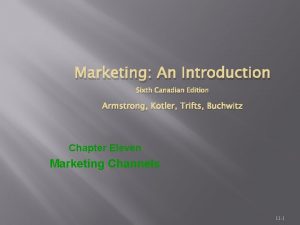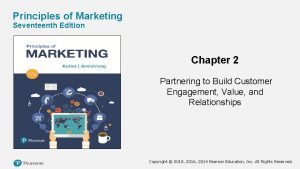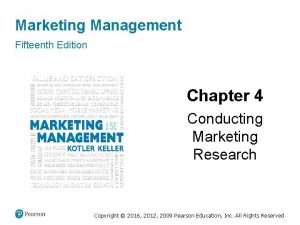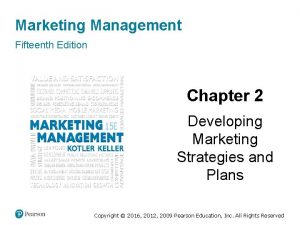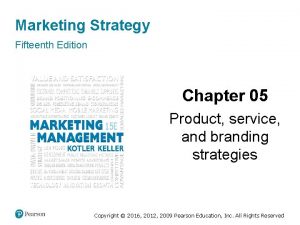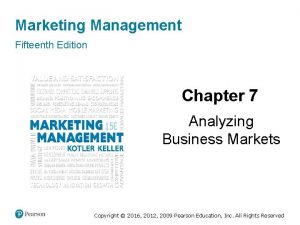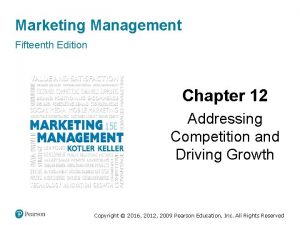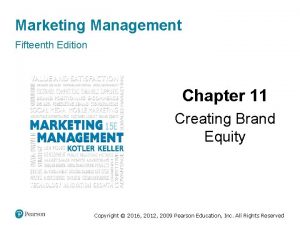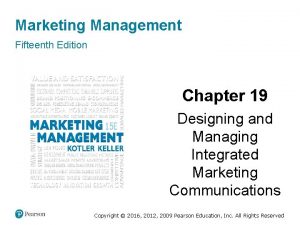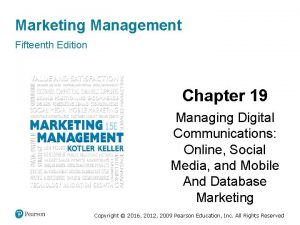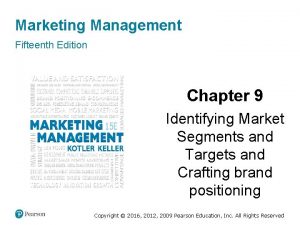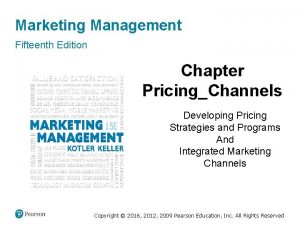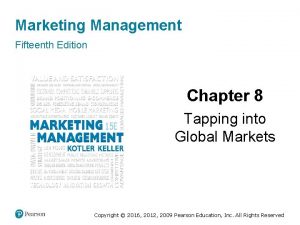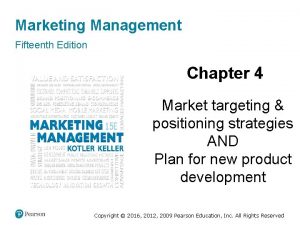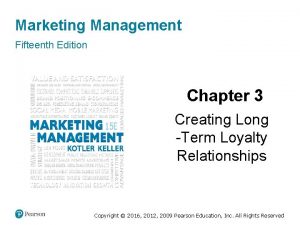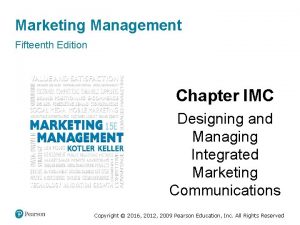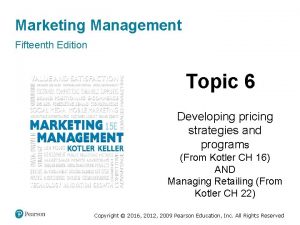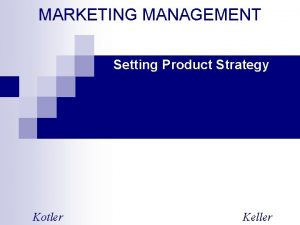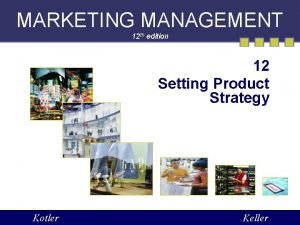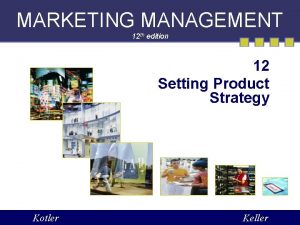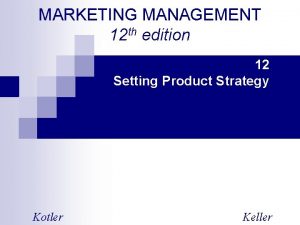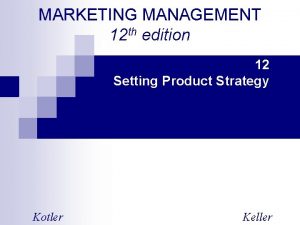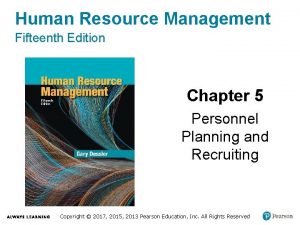Marketing Management Fifteenth Edition Chapter 13 Setting Product






























- Slides: 30

Marketing Management Fifteenth Edition Chapter 13 Setting Product Strategy Copyright © 2016, 2012, 2009 Pearson Education, Inc. All Rights Reserved

Learning Objectives (1 of 2) 13. 1 What are the characteristics of products, and how do marketers classify product? 13. 2 How can companies differentiate products? 13. 3 Why is product design important, and what are the different approaches taken? 13. 4 How can marketers best manage luxury brands 13. 5 What environmental issues must marketers consider in their product strategies? 13. 6 How can a company build and manage its product mix and product lines? Copyright © 2016, 2012, 2009 Pearson Education, Inc. All Rights Reserved

Learning Objectives (2 of 2) 13. 7 How can companies combine products to create strong co-brands or ingredient brands? 13. 8 How can companies use packaging, labeling, warranties, and guarantees as marketing tools? Copyright © 2016, 2012, 2009 Pearson Education, Inc. All Rights Reserved

Product Characteristics and Classifications • Product – Anything that can be offered to a market to satisfy a want or need, including physical goods, services, experiences, events, persons, places, properties, organizations, information, and ideas Copyright © 2016, 2012, 2009 Pearson Education, Inc. All Rights Reserved

Figure 13. 1 Components of the Market Offering Copyright © 2016, 2012, 2009 Pearson Education, Inc. All Rights Reserved

Product Levels: The Customer-Value Hierarchy Figure 13. 2 Five Product Levels Copyright © 2016, 2012, 2009 Pearson Education, Inc. All Rights Reserved

Product Classifications • Durability • Tangibility • Use Copyright © 2016, 2012, 2009 Pearson Education, Inc. All Rights Reserved

Durability and Tangibility • Nondurable goods • Durable goods • Services Copyright © 2016, 2012, 2009 Pearson Education, Inc. All Rights Reserved

Consumer-Goods Classification • Convenience • Shopping • Specialty • Unsought Copyright © 2016, 2012, 2009 Pearson Education, Inc. All Rights Reserved

Industrial-Goods Classification • Materials and parts • Capital items • Supplies and business services Copyright © 2016, 2012, 2009 Pearson Education, Inc. All Rights Reserved

Product Differentiation • Form • Reliability • Features • Repairability • Performance quality • Style • Conformance quality • Customization • Durability Copyright © 2016, 2012, 2009 Pearson Education, Inc. All Rights Reserved

Services Differentiation • Ordering ease • Delivery • Installation • Customer training • Customer consulting • Maintenance and repair • Returns Copyright © 2016, 2012, 2009 Pearson Education, Inc. All Rights Reserved

Design (1 of 2) • Design – The totality of features that affect the way a product looks, feels, and functions to a consumer Copyright © 2016, 2012, 2009 Pearson Education, Inc. All Rights Reserved

Design (2 of 2) • Is emotionally powerful • Transmits brand meaning/positioning • Is important with durable goods • Makes brand experiences rewarding • Can transform an entire enterprise • Facilitates manufacturing/distribution • Can take on various approaches Copyright © 2016, 2012, 2009 Pearson Education, Inc. All Rights Reserved

Luxury brands • Quality • Uniqueness • Craftsmanship • Heritage • Authenticity • History Copyright © 2016, 2012, 2009 Pearson Education, Inc. All Rights Reserved

Marketing Luxury Brands Table 13. 1 Guidelines for Marketing Luxury Brands 1 Maintaining a premium image for luxury brands is crucial; controlling that image is thus a priority. 2 Luxury branding typically includes the creation of many intangible brand associations and an aspirational image. 3 All aspects of the marketing program for luxury brands must be aligned to ensure high-quality products and services and pleasurable purchase and consumption experiences. 4 Besides brand names, other brand elements—logos, symbols, packaging, signage—can be important drivers of brand equity for luxury products. 5 Secondary associations from linked personalities, events, countries, and other entities can boost luxury-brand equity as well. 6 Luxury brands must carefully control distribution via a selective channel strategy. 7 Luxury brands must employ a premium pricing strategy, with strong quality cues and few discounts and markdowns. 8 Brand architecture for luxury brands must be managed carefully. 9 Competition for luxury brands must be defined broadly because it often comes from other categories. 10 Luxury brands must legally protect all trademarks and aggressively combat counterfeits. Copyright © 2016, 2012, 2009 Pearson Education, Inc. All Rights Reserved

Environmental Issues • Environmental issues are also playing an increasingly important role in product design and manufacturing Copyright © 2016, 2012, 2009 Pearson Education, Inc. All Rights Reserved

The Product Hierarchy 1. Need family 2. Product family 3. Product class 4. Product line 5. Product type 6. Item Copyright © 2016, 2012, 2009 Pearson Education, Inc. All Rights Reserved

Product Systems and Mixes • Product system • Product mix/assortment – – Width Length Depth Consistency Copyright © 2016, 2012, 2009 Pearson Education, Inc. All Rights Reserved

Product Line Analysis (1 of 2) • Sales and profits Figure 13. 3 Product-Item Contributions to a Product Line’s Total Sales and Profits Copyright © 2016, 2012, 2009 Pearson Education, Inc. All Rights Reserved

Product Line Analysis (2 of 2) • Market profile and image Figure 13. 4 Product Map for a Paper-Product Line Source: Benson P. Shapiro, Industrial Product Policy: Managing the Existing Product Line (Cambridge, MA: Marketing Science Institute Report No. 77– 110). Copyright © 2003. Reprinted by permission of Marketing Science Institute and Benson P. Shapiro. Copyright © 2016, 2012, 2009 Pearson Education, Inc. All Rights Reserved

Product Line Length • Line stretching – Down-market stretch – Up-market stretch – Two-way stretch • Line filling • Line modernization • Line featuring • Line pruning Copyright © 2016, 2012, 2009 Pearson Education, Inc. All Rights Reserved

Product Mix Pricing • The firm searches for a set of prices that maximizes profits on the total mix – – – Product line pricing Optional-feature pricing Product-bundling pricing Captive-product pricing By-product pricing Two-part pricing Copyright © 2016, 2012, 2009 Pearson Education, Inc. All Rights Reserved

Co-Branding • Two or more well-known brands are combined into a joint product or marketed together in some fashion ‒ ‒ Same-company Joint-venture Multiple-sponsor Retail Copyright © 2016, 2012, 2009 Pearson Education, Inc. All Rights Reserved

Ingredient Branding • Co-branding that creates brand equity for parts that are necessarily contained within other branded products Copyright © 2016, 2012, 2009 Pearson Education, Inc. All Rights Reserved

Packaging (1 of 3) • All the activities of designing and producing the container for a product Copyright © 2016, 2012, 2009 Pearson Education, Inc. All Rights Reserved

Packaging (2 of 3) Used as a marketing tool Packaging objectives • Self-service • Identify the brand • Consumer affluence • Convey descriptive and persuasive information • Company and brand image • Innovation opportunity • Facilitate product transportation and protection • Assist at-home storage • Aid product consumption Copyright © 2016, 2012, 2009 Pearson Education, Inc. All Rights Reserved

Packaging (3 of 3) Table 13. 3 The Color Wheel of Branding and Packaging Red symbolizes excitement, energy, passion, courage, and being bold. Orange connotes friendliness and fun. It combines the energy of red and the warmth of yellow. Yellow, as the color of the sun, is equated with warmth, joy, and happiness. Green, as the color of nature, connotes health, growth, freshness, and renewal. Blue, as the color of the sky and sea, is associated with dependability, trust, competence, and integrity. Purple has symbolized nobility, wealth, and wisdom. It combines the stability of blue and the energy of red. Pink is considered to have soft, peaceful, comforting qualities. Brown, as the color of the earth, connotes honesty and dependability. Black is seen as classic, strong, and balanced. White connotes purity, innocence, and cleanliness. Copyright © 2016, 2012, 2009 Pearson Education, Inc. All Rights Reserved

Labeling, Warranties, and Guarantees • Labeling – Identifies, grades, describes, and promotes the product • Warranties – Formal statements of expected product performance by the manufacturer • Guarantees – Promise of general or complete satisfaction Copyright © 2016, 2012, 2009 Pearson Education, Inc. All Rights Reserved

Copyright © 2016, 2012, 2009 Pearson Education, Inc. All Rights Reserved
 Human resource management fifteenth edition
Human resource management fifteenth edition Human resources department structure
Human resources department structure University physics with modern physics fifteenth edition
University physics with modern physics fifteenth edition Chapter 12 the worlds of the fifteenth century
Chapter 12 the worlds of the fifteenth century The worlds of the fifteenth century
The worlds of the fifteenth century 11 course french classical menu
11 course french classical menu Fifteenth amendment
Fifteenth amendment Marketing management (arab world edition)
Marketing management (arab world edition) Marketing management (arab world edition) philip kotler
Marketing management (arab world edition) philip kotler Marketing management (arab world edition) philip kotler
Marketing management (arab world edition) philip kotler Marketing kotler
Marketing kotler Kotler e keller
Kotler e keller Marketing management (arab world edition) philip kotler
Marketing management (arab world edition) philip kotler Marketing management 12th edition
Marketing management 12th edition Marketing management 12th edition
Marketing management 12th edition Chapter 13 setting product strategy ppt
Chapter 13 setting product strategy ppt Using mis (10th edition) 10th edition
Using mis (10th edition) 10th edition Mis
Mis Management by robbins
Management by robbins Marketing meaning in marketing management
Marketing meaning in marketing management Marketing management definition
Marketing management definition Marketing management introduction
Marketing management introduction Marketing new realities
Marketing new realities Understanding jim crow (setting the setting)
Understanding jim crow (setting the setting) Marketing for hospitality and tourism 7th edition
Marketing for hospitality and tourism 7th edition Marketing an introduction 6th canadian edition
Marketing an introduction 6th canadian edition Marketing for hospitality and tourism chapter 1
Marketing for hospitality and tourism chapter 1 Global marketing 9th edition
Global marketing 9th edition Principles of marketing fifth european edition
Principles of marketing fifth european edition Marketing real people real choices 11th edition
Marketing real people real choices 11th edition Principles of marketing seventeenth edition
Principles of marketing seventeenth edition






